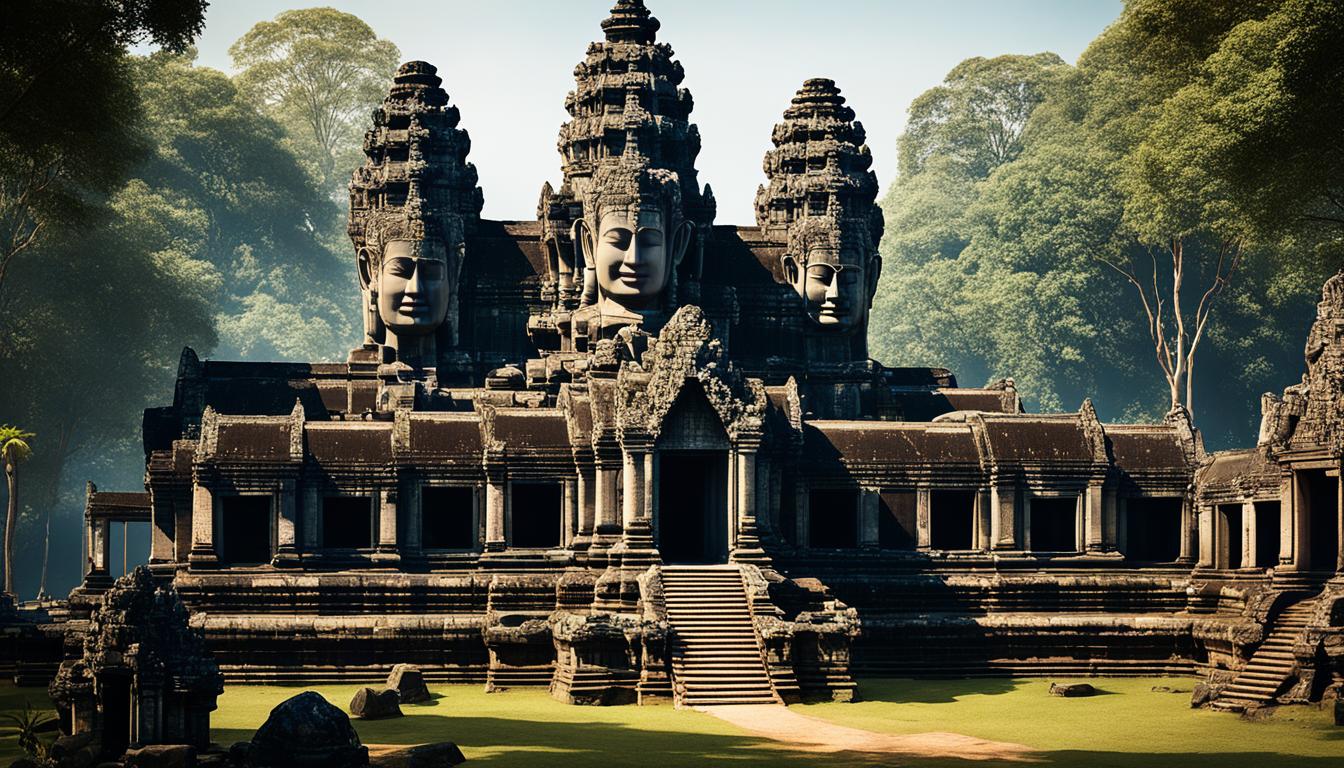Mysteries of the Past: Discovering Cambodia’s Ancient Temples
Ever wondered about the secrets in Cambodia’s ancient temples? How did they get built and then left alone? Let’s take a journey into the past. We’ll explore Angkor, a UNESCO site and Angkor Wat, its famous temple.
These ancient temples were made by the Khmer Empire kings from the 9th to 15th century. They built them like temple-mountains to look like Mt. Meru, where gods lived in Hindu and Buddhist stories. Some temples mix both religions’ symbols. This shows how the empire changed its main faith.
Angkor Wat, dedicated to the Hindu god Vishnu, stands in the Angkor complex. It was built in the 12th century. This temple is a huge symbol of the Khmer Empire’s strength. It’s covered in detailed carvings and tells stories from Hindu myths.
Why did Angkor Wat and other temples get abandoned around the 15th century? Historians don’t know for sure, so it’s still a big mystery. In the 19th century, Western missionaries showed the world the temple’s beauty. Today, Angkor Wat welcomes visitors from everywhere with its stunning grace.
Key Takeaways:
- The ancient temples of Cambodia were commissioned by the Khmer Empire from the 9th to the 15th century.
- These temples were built in the style of temple-mountains, symbolizing Mt. Meru.
- Some temples incorporate symbolism from both Hinduism and Buddhism.
- Angkor Wat, dedicated to Vishnu, is the most renowned temple-mountain.
- The reasons behind the abandonment of the temples in the 15th century remain a mystery.
Temples of Angkor: Architectural Splendor and Spiritual Significance
The Angkor area, besides Angkor Wat, has many other stunning temples. These temples show off amazing architecture and deep spiritual meaning. They stand as proof of the smart designs and rich culture of the Khmer Empire.
Angkor Thom: A Symbol of Power and Grandeur
Angkor Thom was the last capital of the Khmer Empire, known for its might and beauty. It was built in the 12th century. Inside its walls, you’ll find temples that celebrate the empire’s religious and political power.
“Angkor Thom is an awe-inspiring testament to the Khmer Empire’s architectural prowess and cultural legacy.” – Historian, Dr. Sophie Nelson
Bayon Temple: The Smiling Faces of Divine Kings
The heart of Angkor Thom hosts the Bayon temple, famous for its many smiling stone faces. These faces might look like divine kings or Avalokiteshvara, a Buddhist figure. The temple also points to the switch from Hinduism to Buddhism under King Jayavarman VII.
Ta Prohm: Nature’s Embrace and Transcendent Wisdom
Ta Prohm is almost taken over by nature, showing how powerful time can be. Gigantic trees, lush plants, and old ruins mix to make a mystical place. The area feels unique, with tree roots and branches all around. It tells stories of wisdom and faith through detailed carvings.
Discover Siem Reap: Gateway to the Temples
Siem Reap is the perfect spot to start exploring Angkor. It combines modern life with local beauty. This city is also the home base for temple visits. Siem Reap province is famous for its temples filled with detailed carvings. A trip here is a chance to see the wonders of Angkor and be part of Khmer culture.
The Timeless Allure of Angkor: Connecting with History and Culture
Angkor isn’t just about temples. It’s like a living history book. It shows the life of the Khmer people and their vanished empire from the 15th century.
Ta Prohm stands out at Angkor, with ancient stones and nature mixing. Walking its paths makes you feel amazed. The trees growing with the temple show us time’s unstoppable march.
You can feel Angkor’s spirituality in many ways. Start with a sunrise meditation at Pre Rup. The early morning sun over old ruins can bring a calmness and spiritual connection.
Siem Reap is where you usually start your Angkor exploration. It’s lively and blends old traditions with new comforts. At the Old Market, local artists sell their crafts, offering a peek into Siem Reap’s rich culture.
Don’t miss Cambodian food when in Angkor. Try Amok, a coconut curry with fish, and Nom Banh Chok, rice noodles with herbs and gravy. These dishes bridge the country’s past with its diverse cooking styles.
When you visit Angkor, think about the impact you have. Walk only on marked paths to protect the ancient sites. Use a reusable water bottle to cut down on trash. Your choices help keep Angkor’s beauty for others to enjoy later.







